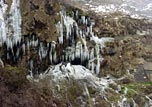Tour in the North
GOVERNORATE OF the North
NINEVEH (MOSUL):
Mosul, the City of two springs (Autumn and Spring are very much alike in
this city). It is also called Al Hadba, Al Faiha, and Al khadra.
Mosul is north largest city and major center of trade, industry and
communications. It has second largest university in Iraq. 400 km from
Baghdad, it is linked with the capital by an excellent high way, railways
with a regular daily trips, and daily regular flights.
The city has been continuously inhabited since Assyrian times. Long before
Islam, a number of Arab tribes had settled in it. It is rich in historical
places, castles, mosques, churches, monasteries and schools.
DUHOK:
At a distance of 73 kms from Mosul lies Duhok at an opening in the mountain
also called Duhok. It is known nationwide for its vast vineyards and
excellent grapes, figs and pomegranates. The area is rich in scenic beauty,
where nature is lavish with water and vegetation. There are several sites
and summer resorts in it.
Before getting to it the visitor will see an old tell with the ruins of a
castle, an indication of an ancient settlement, which probably, dates back
to Assyrian times.
SULAYMANIYA:
It is famous with its walnut trees particularly in Biyara and Twaila. These
two villages are also famed, apart from natural beauty, for their vineyards.
The oldest cultural settlement in this area goes back to Paleolithic times.
When written history begins we find that the Assyrians called Sulaymania and
Shahrazour plain by the name of “Samwa”. In Derbandhawa, Kara Dagh
Mountains, the Akkadian king Naram sin (2291-2255) immortalized his victory
over the enemy in a famous stela of great artistry.
ARBIL:
It is the most important place in the world for the study of the culture of
Neanderthal man, 3500 – 70,000 years ago. Cunei-form inscriptions suggest
that Arbil was a very well known towards the end of the 3rd millennium B.C.
Syrian inscriptions of the second millennium refer to it as Urbilum or
Arbilum. In Assyrian and Babylonian texts it is called Arba ilu (the four
gods). The city is almost half way between Mosul and Kirkuk: 86 km away from
the former, 93 from the latter.
SALAHUDIN (Samarra):
About 74 years after the foundation of Baghdad, the Abbasid caleph Al
mu’tasim moved his capital north to the newly built city of Samarra, in A.D.
836. Its heyday however was under Caliph Al mutawakkil (A.D. 847 – 861) The
remains of the ancient Samarra are visible along the eastern bank of the
Tigris, stretching south of the modern city for nearly 35 kms: the great
mosque, the spiral minaret, Balkwara palace, ma’shouq palace etc.
KERKUK:
This governorate played a major role in man’s early history, from early
Paleolithic times (100,000 years ago) in Parda Balka, down to the Neolithic
age (8,000 years ago).
The earliest farming village in the world, where man learned to plant seeds
for the first time, is Jarmo, near Chamchamal in this part of Iraq. Another
spot of ancient historical interest in Nuzi Yorgan Tappeh, 25 kms. To the
south east of Kirkuk, the center of the governorate, where excavators
discovered dwellings, a temple, a palace, cuneiform inscriptions of a legal
and economic nature, all of which go back to the middle of the second
millennium B.C. This period was noted for its particularly fine pottery,
which has been called after the village. Even more ancient traces here go
back to the Sumerians and Akkadians, who called the town Ga-Sur. It was here
that the most ancient map in the world was found – it belonged to the
Akkadian Era, 4,300 years ago.
In Kirkuk you will see the castle, one of its oldest extant monuments, as
well as the eternal fire at Baba Gurgur.


